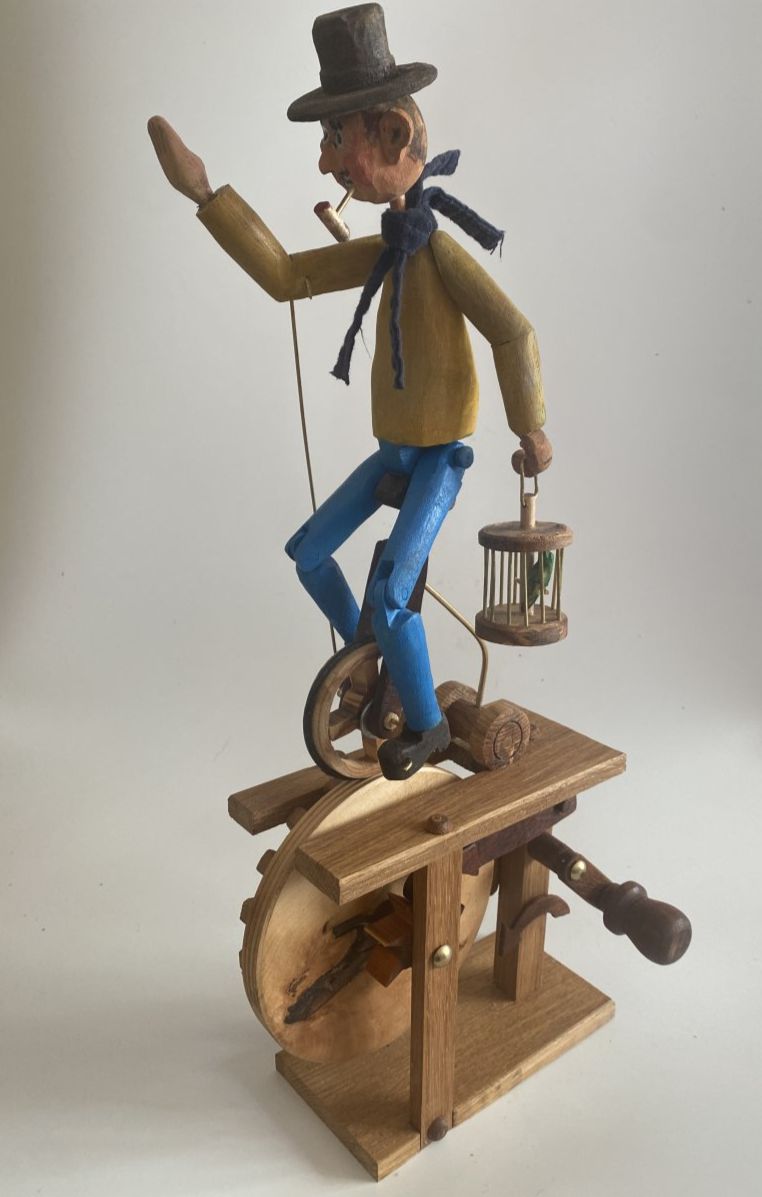
Automaton Article.
WELCOME
The Starting Point
I start by sketching out my vision from various designs and ideas I come across. The design phase is critical, as it determines the complexity of the mechanism and the aesthetic appeal of the finished piece. I use mostly repurposed wood as my primary material to make my marvels. I try to be environmentally aware in my art and depends on what hardwood i can get my hands on. My main choice it Oak and Teak type woods due to their colour and grain,
The Prototype
Once the design is finalized I make a rough softwood prototype rather than making reams of technical drawing. I work from plans in my head rather than on paper. As a skilled woodworker I begin by selecting the right pieces of wood and carefully shaping them to create the various components of the automaton. I cut all my components with a band saw or scroll saw including gears. This may involve carving intricate figures and scenes or cutting precise gear teeth using specialized tools such as files and rasps.
For me the cutting and preparation of the components is fairly straightforward. I generally build as i go used my prototype as my reference. The difficult bit is assembly and to get it to work correctly and smoothly. I believe this is where the true skill of the maker is tested.
Assembly and Testing
Once the automaton is assembled, I give it a rigorous test' I carefully observe its movements, making adjustments to the mechanism as needed to ensure smooth and accurate motion. This process can be time-consuming, as even minor adjustments can have a significant impact on performance.
The final step involves adding artistic elements to the automaton. This may include painting and decorating the wooden figures to bring the scene to life.
Gears
The final step involves adding artistic elements to the automaton. This may include painting and decorating the wooden figures to bring the scene to life.
Gears
Wooden automaton are intriguing mechanical devices that have fascinated people young and old for centuries.
These interesting creations combine the skill of the maker of with the ingenuity of engineering.
Gears are fundamental part of any automaton. They transfer rotational motion from one part of the mechanism to another. I aways make the gears from Hardwood for a more accurate mesh of the teeth and smooth operation.
Cranks and Levers
Working alongside the gears are cranks and levers these convert rotary action into linear motion, enabling specific actions within the mechanics. The cranks turn in a circular motion, levers move backwards and forwards, often driven by cams or other mechanisms. My Magical Marvels are driven by gears, levers, and cams that convert rotating motion into a series of different movements.
Cams
Cams are attached to a rotating shaft, and as the cams turn, the levers or rods to move in a certain way. The shape and design of the cam determines the movement it generates allowing for a wide range of uses in overall design. Cams can vary between an irregular shape or a regular round shape that control the timing and of movement in my creations.
Springs
I have occasionally used springs mainly for a "Snap Back" movement.. They are essential for producing repetitive or oscillating movements. When wound or compressed, a spring stores potential energy, which is gradually released to drive the automaton's motion.
Linkages
Linkages directly connect elements that transfer motion from one part of the automaton to another. They can take various forms, including rods, belts, and chains. I would generally use brass rod linkages rather than belts and chains......less complicated and not prone to failure.
..............................................................................
My Magical Marvels are a testament to the joining of art and mechanics. These mechanical wonders will hopefully delight people for generations with their intricate movements and charming scenes. Understanding the mechanics behind wooden automata and the craftsmanship required to create them provides a deeper insight and appreciation for these captivating creations. Whether they tell a story, depict a scene from nature, or simply provide a sense of wonder, wooden automata continue to enchant and inspire audiences worldwide
Alongside the intricate crafted mechanisms, my Magical Marvels sometimes have an artistic touch and I occasionally add detail like crafted wooden figures, scenes, and decorations. These additions give a true life effect and character to my work, making them more visually appealing and engaging. However I do like to display the natural wood grain my creations are made of without too much strong colour. These elements give a true life effect and character to my work, making them more visually appealing and engaging. Creating a wooden automaton is a meticulous and skilled process that requires a deep understanding of mechanics and art and woodworking.
The Automata Maker joins art and mechanics to craft wooden automata with a focus on natural and re-purposed wood with special attention to the wood grain. This involves design, softwood prototypes, careful assembly, and testing. Gears, cranks, levers, cams, springs, and linkages form the basis of his mechanisms. The result is a fusion of art and engineering, aiming to enchant generations to come.
The Automata Maker
Please feel free to use my article as long as you post a link to my website The Automata Maker.co.uk
copyright ©2023 The Automata Maker All rights reserved.
